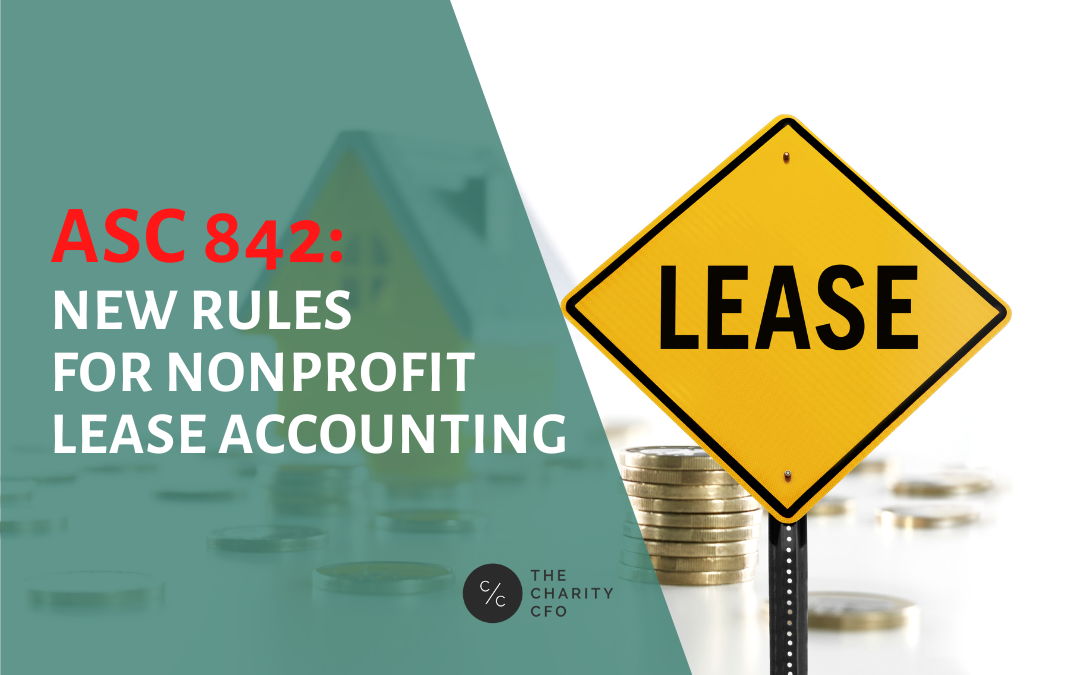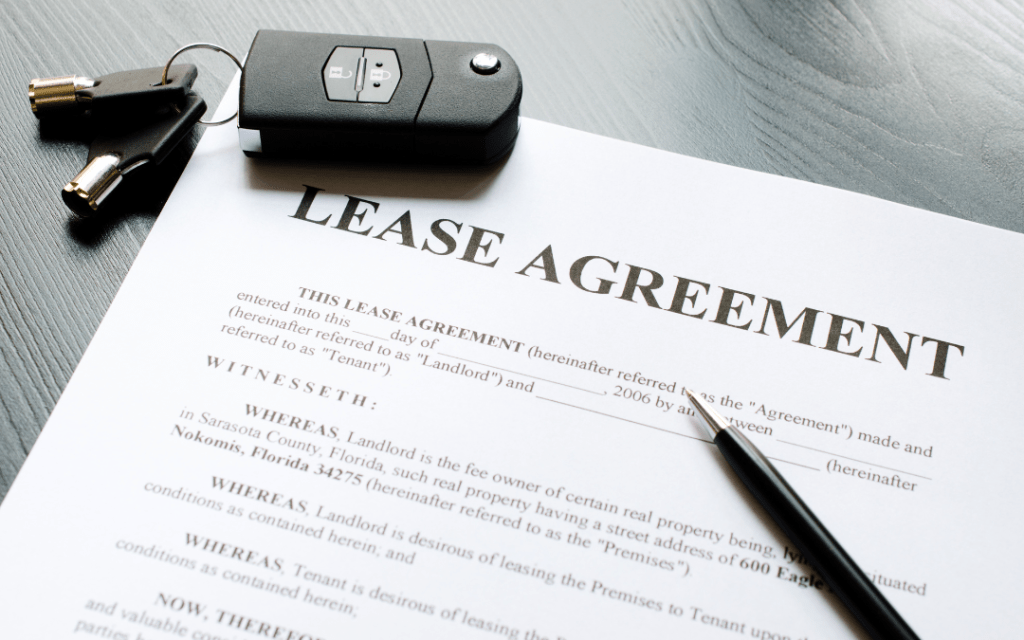Updated standards on accounting for nonprofit leases (ASC 842) go into effect this year for most organizations–and next year for the few remaining exceptions.
If you’re not sure that your organization has adopted the new standards detailed in ASC 842, then keep reading. We’ll tell you all you need to know about complying with these new rules when accounting for leases of all types.
What is ASC 842 for nonprofit lease accounting?
All nonprofit accounting rules in the United States are defined and codified by the Financial Accounting Standards Board, or “FASB”.
Back in 2016, FASB revised its rules related to accounting for leases, which impact any contract to rent property or equipment that lasts more than 12 months. This update to the rules for lease accounting is referred to as ASC 842.
“ASC” stands for Accounting Standards Codification, and 842 represents the section of the FASB guidance covering leases. ASC 842 supersedes ASC 840, which were FASB’s preexisting lease standards.
ASC 842 requires more complex reporting of leases on the statement of activities (income statement), statement of financial position (balance sheet), and footnotes. And the rule changes will impact a large percentage of nonprofit organizations.
When does ASC 842 take effect?
ASC 842 was issued in 2018, but nonprofit organizations were given an extended period of time before they were required to adopt them. Unfortunately, that period of time has just about expired for almost all organizations.
The new rules go into effect for fiscal year 2022 for nonprofit organizations with a calendar year-end in 2022. For organizations on a fiscal year-end other than December 31st, the rules will not take effect until the fiscal year ending in 2023.
Not compliant? Don’t Panic! There’s still time.
If this is the first you are hearing of these new rules, there is no reason to panic.
Technically, nonprofit organizations have until their year-end audit, review, or compilation to implement these new standards. As long as the new standard is adopted and incorporated into your final, end-of-year financial statements, you are good.
However, we recommend that you get a head start on understanding these rules so that you are prepared to close your books at the end of the year and comply with the new standards.
What is a lease, exactly?
When you think of “leases,” you probably think about your property or building lease. And while that undoubtedly is a lease, ASC 842 adapts a much broader definition of a lease.
According to ASC 842, a lease a contract in which a ‘lessor’ grants a ‘lessee’ control of an identifiable asset for a specific period of time in exchange for payment.
Under this definition, you might have many contracts which constitute a lease. Examples include copier machines, postage meters, furniture, and even computers.
We recommend that you take an inventory of your existing contracts to identify any potential leases that your organization is a party to, but that doesn’t mean that you’ll need to report every lease on your balance sheet.
While the new rule adopts a very broad definition of a lease, it many lease contracts do not meet a materiality threshold that warrants the adoption of the new lease standard. In other words, if you have a small copier lease with an insignificant or immaterial monthly payment, you are justified in excluding that lease from consideration under the new lease standard.
PRO TIP: Consult your CPA for guidance on which leases might be considered immaterial. The last thing you want to do is waste your time on complex lease accounting for a lease that is not material or mistakenly omit a lease that is considered material.
In most circumstances, property or building leases will be material. So while you may not have to worry about every lease that your organization is a part of, you will likely still need to implement ASC 842 standards for your largest leased assets.
What is different under ASC 842?
For starters, the old lease rules, ASC 840, differentiated between two types of leases: operating leases and capital leases. Although ASC 842 makes a similar distinction, what were previously called capital leases are now referred to as “finance leases.”
The distinction between finance vs. operating leases is beyond the scope of this article, but there is a five-part criteria for distinguishing between the two. If any one of the five criteria is met, the lease is considered a finance lease.
In practice, we tend to find that operating leases are far more common for small to mid-sized nonprofit organizations.
Historically, organizations had to record finance leases with a lease liability account and corresponding right-of-use lease asset on the balance sheet. This is referred to as the ‘balance sheet approach,’ and it allows stakeholders to easily see the value of lease payments remaining on any leases. As the lease term progresses, the liability ‘amortizes,’ or slowly decreases in conjunction with the asset.
That’s a lot of technical lingo, but under the old rules, a finance lease required nonprofits to disclose a large liability on their books to represent the fact that the nonprofit was contractually required to make future payments.
Under the new standards detailed in ASC 842), both finance and operating leases must use the ‘balance sheet approach.’
The new standard still makes some distinctions between operating and finance leases, but both must now be reported on the balance sheet with a lease liability and corresponding right-of-use asset.
How to report your leases on financial statements under ASC 842
Until now, most nonprofits have just recorded a ‘lease expense’ on their statement of activities every month when they make their lease payments. There was no change to the balance sheet other than the decrease in cash when payments were made (unless of course, you had a capital lease).
Moving forward, virtually all leases must report a lease liability and right-of-use asset on their balance sheet.
There is still a monthly lease expense on the statement of activities under the new standard, but the balance sheet presentation requirements are new unless you already had a capital/finance lease on your books.
REMINDER: Immaterial leases can generally be excluded from the new lease standards and be reported on the statement of activities with no balance sheet impact. But consult with your CPA to determine which of your leases might be considered immaterial.
Why does this matter?
ASC 842 matters for two main reasons.
The first is that most nonprofit organizations don’t want to show large liabilities on their balance sheets. Donors and funders generally want to see a healthy ratio of assets to liabilities.
ASC 842 will create better transparency about your nonprofit’s future financial obligations. But it will also result in significantly higher liabilities on the balance sheet of most nonprofits. The good news is that everyone is going through this together, so educated donors will know the reason for the sudden change.
The second reason ASC 842 matters is that calculating and reconciling these lease liability and right-of-use asset accounts can get complicated. The calculation depends on many factors, including your incremental borrowing rate for discounting the lease payments, the term of your lease, any leasehold incentives or rent abatement, and lease renewal options.
You’ll need to spend some time analyzing your lease agreement(s) to get a strong understanding of the lease payment schedule, the term of the lease, and any incentives or options.
Then you’ll need to calculate the appropriate balances and create a lease schedule. If your team isn’t up to the task, it might be time to consider outsourcing your bookkeeping to a professional nonprofit accounting team.
How does ASC 842 impact in-kind rent?
Many nonprofit organizations receive rent as an in-kind gift, meaning their landlord donates rentable space at no cost to the nonprofit. Historically, in-kind rent is treated as any other in-kind contribution; in-kind revenue is recorded in conjunction with a corresponding in-kind expense on the statement of activities.
The good news is that organizations falling into this category will not have to change their reporting, as the new rules do not impact in-kind rent. That will save many nonprofits from making significant changes to their lease accounting processes.
TL;DR
New changes to nonprofit accounting rules regarding leases (ASC 842) require nonprofits to report almost all leases to the balance sheet and not simply the statement of activities. Most nonprofits must comply with the new rules by the end of the fiscal year 2022, and all nonprofits must be compliant by the end of fiscal year 2023.
Final Thoughts on accounting for nonprofit leases
The new lease standards are here to stay, and that’s mostly a good thing because ASC 842 will create more transparent reporting of lease-related liabilities on your balance sheet.
However, it will take some time and energy to implement. So make time now to analyze your lease agreements to understand how these changes will impact your nonprofit’s financials. And be sure to explain those changes to your stakeholders, so they’re not caught off guard.
Finally, if you’re unsure how to implement the new standards, or your nonprofit is ready for some professional financial guidance, reach out to The Charity CFO to see how we ca

Do You Struggle to Make Sense of Your Financial Statements?
Get our FREE GUIDE to nonprofit financial reports, featuring illustrations, annotations, and insights to help you better understand your organization's finances.
Get the free guide!





0 Comments